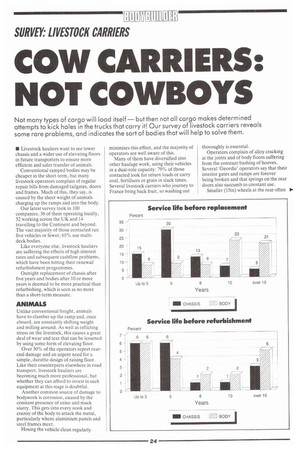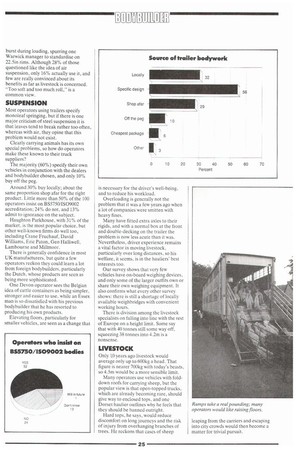COW CARRIERS: NOT COWBOYS
Page 120

Page 121

If you've noticed an error in this article please click here to report it so we can fix it.
Not many types of cargo will load itself— but then not all cargo makes determined attempts to kick holes in the trucks that carry it! Our survey of livestock carriers reveals some rare problems, and indicates the sort of bodies that will help to solve them.
• Livestock hauliers want to see lower chassis and a wider use of elevating floors in future transporters to ensure more efficient and safer transfer of animals.
Conventional ramped bodies may be cheaper in the short term, but many livestock operators complain of regular repair bills from damaged tailgates, doors and frames. Much of this, they say, is caused by the sheer weight of animals charging up the ramps and into the body.
Our latest survey took in 100 companies, 36 of them operating locally, 52 working across the UK and 14 travelling to the Continent and beyond. The vast majority of those contacted run five vehicles or fewer; 65% use multideck bodies.
Like everyone else, livestock hauliers are suffering the effects of high interest rates and subsequent cashflow problems, which have been hitting their renewal/ refurbishment programmes.
Outright replacement of chassis after five years and bodies after 10 or more years is deemed to be more practical than refurbishing, which is seen as no more than a short-term measure.
ANIMALS
Unlike conventional freight, animals have to clamber up the ramp and, once aboard, are constantly shifting weight and milling around. As well as inflicting stress on the livestock, this causes a great deal of wear and tear that can be lessened by using some form of elevating floor.
Over 30% of the operators report rearend damage and an urgent need for a simple, durable design of raising floor. Like their counterparts elsewhere in road transport, livestock hauliers are becoming much more professional, but whether they can afford to invest in such equipment at this stage is doubtful.
Another common source of damage to bodywork is corrosion, caused by the constant presence of urine and muck slurry. This gets into every nook and cranny of the body to attack the metal, particularly where aluminium panels and steel frames meet.
Hosing the vehicle clean regularly minimises this effect, and the majority of operators are well aware of this.
Many of them have diversified into other haulage work, using their vehicles in a dual-role capacity: 79% of those contacted look for return loads or carry coal, fertilisers or grain in slack times. Several livestock carriers who journey to France bring back fruit, so washing out thoroughly is essential.
Operators complain of alloy cracking at the joints and of body floors suffering from the constant bashing of hooves. Several 'Geordie' operators say that their interior gates and ramps are forever being broken and that springs on the rear doors also succumb to constant use.
Smaller (15in) wheels at the rear often 0 burst during Loading, spurring one Warwick manager to standardise on 22.5in rims. Although 28% of those questioned like the idea of air suspension, only 16% actually use it, and few are really convinced about its benefits as far as livestock is concerned. "Too soft and too much roll," is a common view.
SUSPENSION
Most operators using trailers specify monoieaf springing, but if there is one major criticism of steel suspension it is that leaves tend to break rather too often, whereas with air, they opine that this problem would not exist.
Clearly carrying animals has its own special problems, so how do operators make these known to their truck suppliers?
The majority (60%) specify their own vehicles in conjunction with the dealers and bodybuilder chosen, and only 10% buy off the peg.
Around 30% buy locally; about the same proportion shop afar for the right product. Little more than 50% of the 100 operators insist on BS5750/IS09002 accreditation; 24% do not, and 13% admit to ignorance on the subject.
Haughton Parkhouse, with 31% of the market, is the most popular choice, but other well-known firms do well too, including Crane Fruehauf, David Williams, Eric Pawn, Geo Halliwell, Lambourne and Millmoor.
There is generally confidence in most UK manufacturers, but quite a few operators reckon they could learn a lot from foreign bodybuilders, particularly the Dutch, whose products are seen as being more sophisticated.
One Devon operator sees the Belgian idea of cattle containers as being simpler, stronger and easier to use, while an Essex man is so dissatisfied with his previous bodybuilder that he has resorted to producing his own products.
Elevating floors, particularly for smaller vehicles, are seen as a change that is necessary for the driver's well-being, and to reduce his workload.
Overloading is generally not the problem that it was a few years ago when a lot of companies were smitten with heavy fines.
Many have fitted extra axles to their rigids, and with a normal box at the front and double-decking on the trailer the problem is now less acute than it was. Nevertheless, driver experience remains a vital factor in moving livestock, particularly over long distances, so his welfare, it seems, is in the hauliers' best interests too.
Our survey shows that very few vehicles have on-board weighing devices, and only some of the larger outfits own or share their own weighing equipment. It also confirms what every other survey shows: there is still a shortage of locally available weighbridges with convenient working hours.
There is division among the livestock specialists on falling into line with the rest of Europe on a height limit. Some say that with 40 tonnes still some way off, squeezing 38 tonnes into 4.2m is a nonsense.
LIVESTOCK
Only 1.0 years ago livestock would average only up to 600kg a head. That figure is nearer 700kg with today's beasts, so 4.5m would be a more sensible limit.
Many operators use vehicles with folddown roofs for carrying sheep, but the popular view is that open-topped trucks, which are already becoming rare, should give way to enclosed tops, and one Dorset haulier outlines why he feels that they should be banned outright.
Hard tops, he says, would reduce discomfort on long journeys and the risk of injury from overhanging branches of trees. He reckons that cases of sheep leaping from the carriers and escaping into city crowds would then become a matter for trivial pursuit.




































































































































